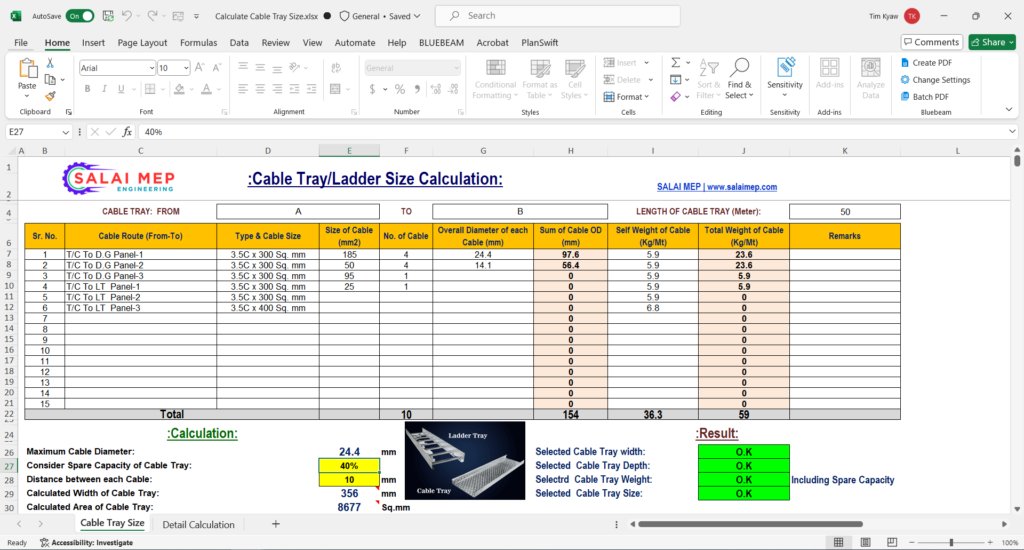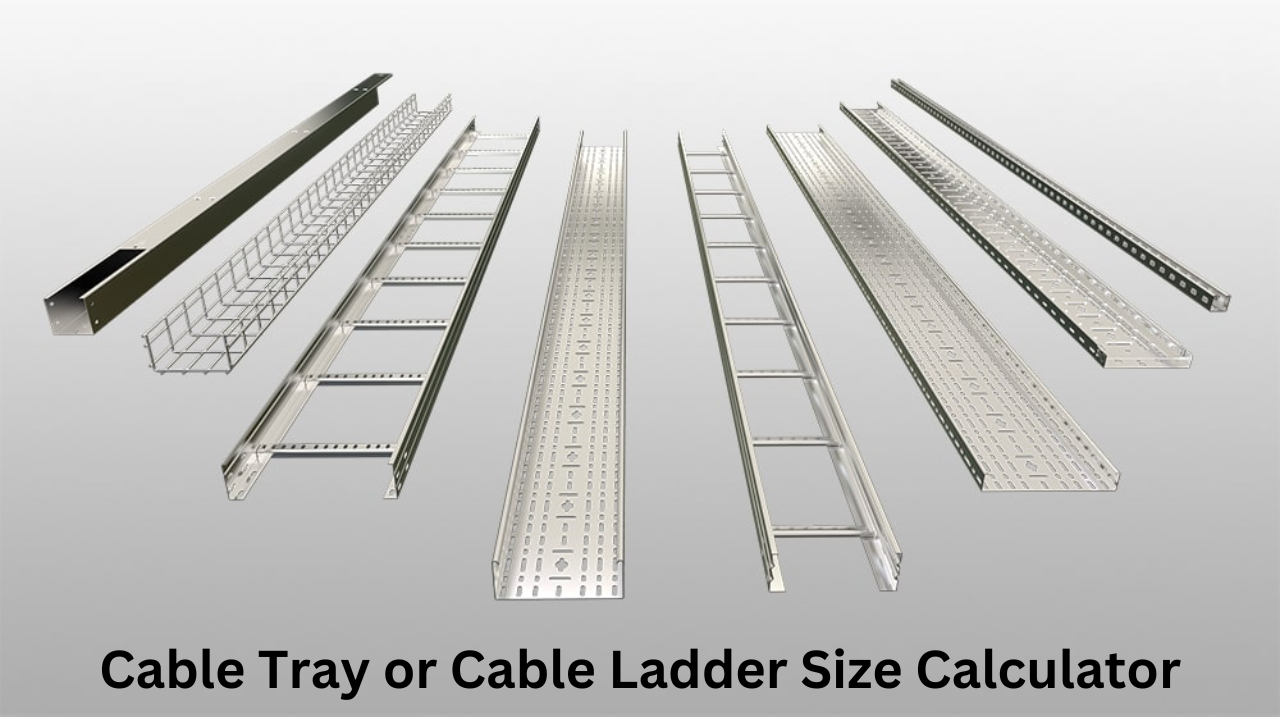Calculation Sheet Detail
- No need to input data in the red color high-light
- Enter the cable information in the sheet.
- Enter the value in the yellow color high-ligh.
- The result will show “OK” with Green high-light.
- If “Error” occur in the Result, re-enter the Cable Tray or Cable Ladder size.
Alternate Calculation Sheet >> Cable Trunking Size Calculator
Cable Tray Sizing involves several steps to ensure that it can support the cables it will carry while meeting electrical and safety standards. Here’s a detailed guide:

Steps to Size a Cable Tray
- Identify the Cable Types and Sizes:
- Determine the number and types of wires (e.g., power, control, signal) that will be placed in the cable tray sizing.
- Obtain the diameters and cross-sectional areas of each cable type.
- Calculate the Total Cross-Sectional Area:
- Calculate the cross-sectional area of each cable type.
- Sum up the cross-sectional areas of all cables to get the total area.
- Apply Fill Ratio:
- According to standards like NEC (National Electrical Code) or IEC (International Electrotechnical Commission), determine the permissible fill ratio. This is usually around 40-50% for ventilation and heat dissipation.
- Divide the total cross-sectional area of wire by the fill ratio to get the minimum cross-sectional area of the cable tray.
- Select Tray Dimensions:
- Based on the calculated minimum cross-sectional area, choose a cable tray width and height that meets or exceeds this requirement.
- Ensure the chosen cable tray sizing allows for future expansion if needed.
- Consider Cable Weight:
- Calculate the weight of the wires and ensure the cable tray can support this weight without sagging or structural failure.
- Environmental and Installation Factors:
- Consider environmental factors such as temperature, chemical exposure, and mechanical impact, which may affect the choice of tray material (e.g., steel, aluminum, fiberglass).
- Determine whether a solid bottom, ventilated, or ladder-type tray is needed based on the installation environment and wire type.
Example Calculation of Cable Tray Sizing
- Identify Cables:
- Suppose you have the following cables:
- 10 power wires (diameter: 20 mm each)
- 20 control wires (diameter: 10 mm each)
- 30 signal wires (diameter: 5 mm each)
- Suppose you have the following cables:
- Calculate Cross-Sectional Areas:
- Power wires: 𝜋×(10 mm)2×10=3141.6 mm2π×(10 mm)2×10=3141.6 mm2
- Control wires: 𝜋×(5 mm)2×20=1570.8 mm2π×(5 mm)2×20=1570.8 mm2
- Signal wires: 𝜋×(2.5 mm)2×30=589.05 mm2π×(2.5 mm)2×30=589.05 mm2
- Total area: 3141.6+1570.8+589.05=5301.45 mm23141.6+1570.8+589.05=5301.45 mm2
- Apply Fill Ratio:
- Assuming a 40% fill ratio: 5301.45/0.4=13253.625 mm25301.45/0.4=13253.625 mm2
- Select Tray Dimensions:
- Convert the area to square meters: 13253.625 mm2=0.01325 m213253.625 mm2=0.01325 m2
- Choose tray dimensions (e.g., 100 mm wide by 200 mm high) that provide sufficient space:
- 100 mm×200 mm=20000 mm2100 mm×200 mm=20000 mm2
- This tray size is adequate since 20000 mm² > 13253.625 mm²
- Check Cable Weight:
- Ensure the cable tray can support the weight of all combined. Manufacturer specifications will provide load ratings for various tray types and sizes.
Additional Considerations
- Ventilation: Ensure enough ventilation to prevent overheating.
- Support Spacing: Follow standards for support spacing to prevent sagging.
- Expansion: Leave room for potential future.
Standards and References
- NEC: National Electrical Code (NFPA 70)
- IEC: International Electrotechnical Commission standards
- NEMA VE 1: National Electrical Manufacturers Association standards for metal cable trays
By following these steps and standards, you can accurately size a cable tray sizing for your installation needs.
You can request excel calculation sheet here.
Download : Onedrive, Google Drive










1 thought on “Cable Tray Sizing Calculator Excel Download”